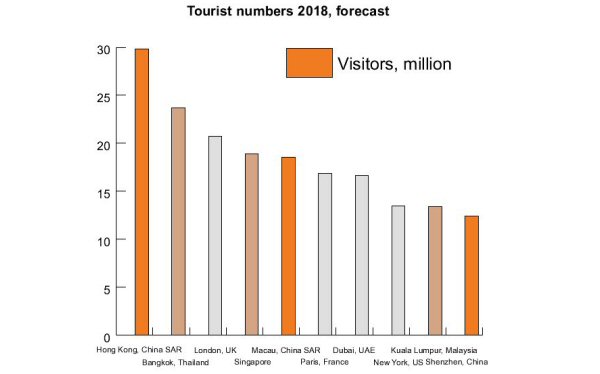Hong Kong is the most obvious beneficiary of the mainland outbound boom, Euromonitor said, as it accounts for more than 50% of all visitors to the city. To further boost Hong Kong’s accessibility from the mainland, the recent completion of the Hong Kong-Zhuhai-Macao Bridge, and the Guangzhou-Shenzhen-Hong Kong Express Rail Link will halve the travel time to Hong Kong from major mainland cities, Euromonitor said.
The HKTB said that in October alone, there were 5.88 million visitors, an 11.5% increase from 2017. Of these arrivals, 79% were from the mainland. The number of mainland visitors grew 15.4% from October 2017, boosted by the Hong Kong-Zhuhai-Macao Bridge opening during the month.
The second-largest set of visitors, from South and Southeast Asia, numbered 394,000 or 5% of overall visitors. Those from Europe, Africa and the Middle East accounted for 229,000 or 3.8% of the total. The 215,000 visitors from North Asia accounted for 3.7% of the October total. The Americas accounted for 180,000 or 3.1%. Taiwan contributed 156,000 or 2.7% while Australia, New Zealand and the South Pacific accounted for 67,000 or 1.1%.
The opening of the Hong Kong-Zhuhai-Macao Bridge in October enhances integration between Hong Kong and its Greater Bay Area neighbours and is likely to further boost visitor numbers. The bridge and the Express Rail Link, which opened earlier this year, give Hong Kong the opportunity to market itself as part of the overall Greater Bay Area.
Following the bridge opening, Peter Lam, Chairman of the HKTB, said: “The HKTB will continue to work closely with Guangdong and Macau, to reinforce the ‘Guangdong-Hong Kong-Macao Greater Bay Area’ branding through promotions on the established ‘Guangdong, Hong Kong & Macau Tourism Marketing Organisation’ platform. We will step up promotions in overseas markets and encourage the travel trade to develop more tourism products featuring the Greater Bay Area to attract overseas visitors.”
In November, the HKTB held the first joint large-scale overseas promotion event with the Guangdong and Macau tourism organisations in Japan to promote tourism in the Greater Bay Area.”
Inbound tourists spent HK$159 billion (US$20.35 billion) in the first six months of 2018, a 13.5% year-on-year increase. Overnight visitors accounted for well over half of this – HK$93 billion – while day trippers spent HK$39 billion. The balance of spending was by cruise passengers and international transport purchases.











